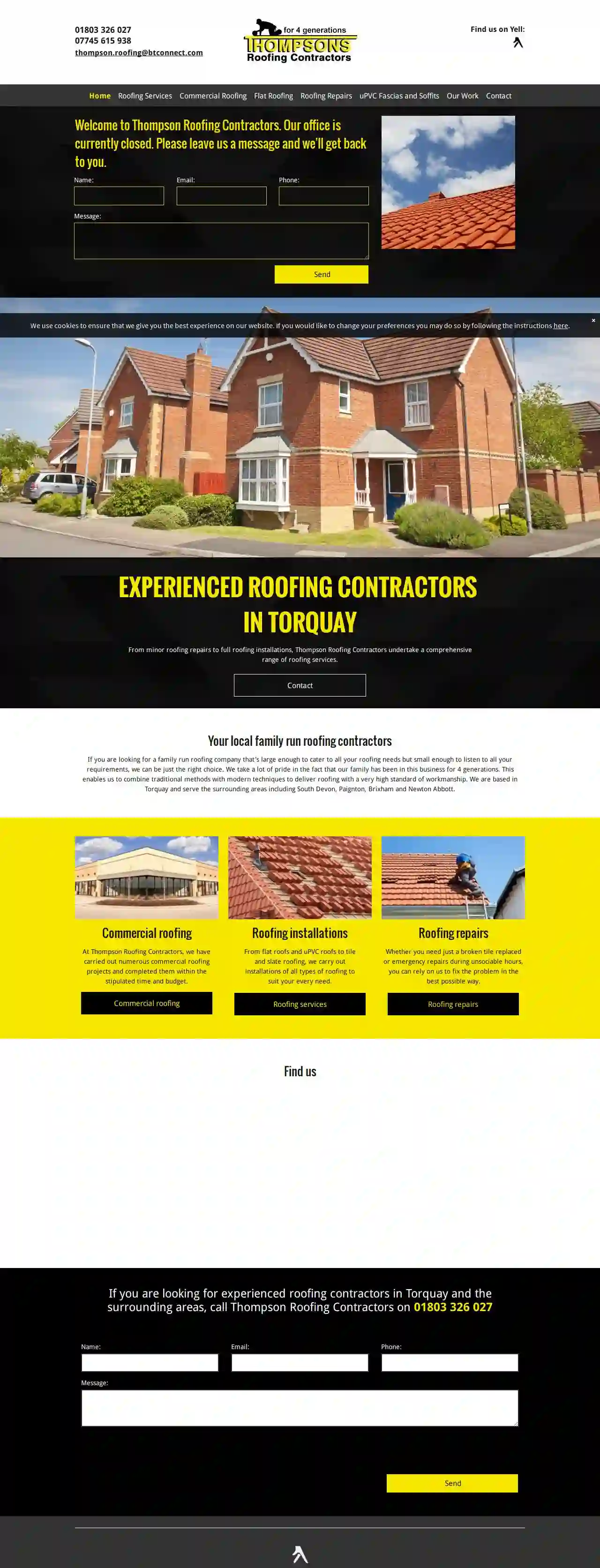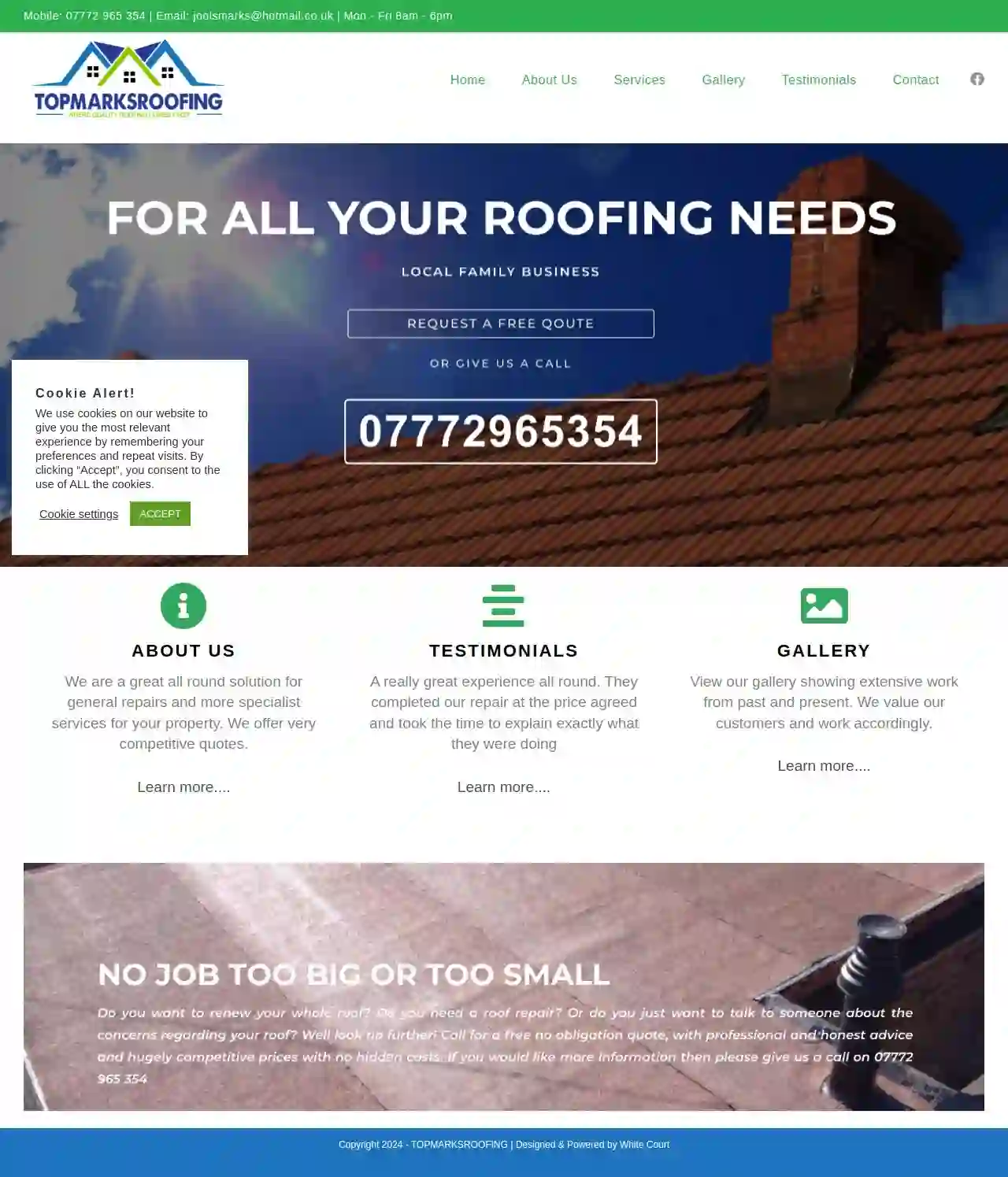Roofing Companies Kingsteignton
Top 10 Roofing Service in Kingsteignton
Get multiple Roofing Contractor quotes for your project today! Compare profiles, reviews, accreditations, portfolio, etc... and choose the best service.

RoofTrain (UK) Ltd
53 reviewsNadderwater, Brooklands Mill, Exeter, EX4 2JG, GBWelcome to RoofTrain UK. We provide professional roof training courses for roofers, builders, electricians, plumbers and others in the building and construction industries. All our courses are run from our specially-built indoor roof training centre near Exeter in Devon. RoofTrain UK and all training courses are operated by Alan Lander. Alan is a dedicated roofer and training professional with more than 40 years' commercial and training experience. Roofing course information I have more than 40 years' commercial roofing experience Alan Lander, RoofTrain UK Find out more about our roofing courses and facilities: professional roof training courses our dedicated roof training centre about RoofTrain UK contact us today to discuss your roof training requirements. Roof training courses and qualification
- Services
- Why Us?
- Our Team
- Gallery
Get Quote
Hi-Tech Flat Roofing Ltd
52 reviews47 Duchy Avenue, Paignton, TQ3 1ER, GBHi Tech Flat Roofing have been operating as single ply membrane flat roof specialists in the Torbay, Devon and South West areas since 2009. As an Approved Contractor and installer for Alkor Flat Roofing Products we can deliver a roof covering solution that is guaranteed for 35yrs. Hi Tech Flat Roofing was established in 2009 bringing commercial flat roofing to the residential market serving the areas of Torbay, Devon and the wider South West region. Alkor flat roofing products have been used since 1982 on hospitals, airports, factories, commercial and residential properties.Architects are now advising or request a single ply membrane on new and refurbished flat roofs. New technologies used in the production of current day roofing products far exceed the traditional flat roof materials.Our installers have over 10 years experience and are approved contractors to install Alkor commercial and residential flat roofs.Over 50% of all staff must be fully Alkor trained on any installation.
- Services
- Why Us?
- Accreditations
- Our Team
- Testimonials
- Gallery
Get Quote
Thompsons
3.73 reviews28A, St Pauls Road, Torquay, TQ1 3QB, GBFrom minor roofing repairs to full roofing installations, Thompson Roofing Contractors undertake a comprehensive range of roofing services. We are a family run roofing company that's large enough to cater to all your roofing needs but small enough to listen to all your requirements. We take a lot of pride in the fact that our family has been in this business for 4 generations. This enables us to combine traditional methods with modern techniques to deliver roofing with a very high standard of workmanship. We are based in Torquay and serve the surrounding areas including South Devon, Paignton, Brixham and Newton Abbott. We have carried out numerous commercial roofing projects and completed them within the stipulated time and budget. We carry out installations of all types of roofing to suit your every need, from flat roofs and uPVC roofs to tile and slate roofing. Whether you need just a broken tile replaced or emergency repairs during unsociable hours, you can rely on us to fix the problem in the best possible way.
- Services
- Why Us?
- Gallery
Get Quote
ALTO ROOFING AND CLADDING LTD
Marsh Barton Trading Estate, Basepoint, Yeoford Way, Exeter, EX2 8LB, GBAlto Roofing & Cladding are an industrial roofing and cladding contractor with over 30 years of specialist experience in industrial and commercial refurbishment projects. Based in Exeter, Devon, we serve customers across the whole of the South of England and South Wales. We offer a free impartial survey service providing you with advice in the form of reports, specifications, estimates and product literature for the recommended options.
- Services
- Why Us?
- Gallery
Get Quote
East Devon Roofing Ltd
4.218 reviewsExeter, GBEast Devon Roofing is a family-run business based in Exeter, serving our customers throughout the South West. With many years experience in all aspects of roofing, our team of fully qualified roofers will ensure your roof is in safe hands. From a simple repair to a complete roof installation, you can be assured of workmanship second to none.
- Services
- Why Us?
- Accreditations
- Our Team
- Testimonials
- Gallery
Get Quote
Slates & Ladders Roofing
4.715 reviews123 Main Street, Brighton, BN1 1AA, GBSlate & Ladders Roofing is a family-run business with over 20 years of experience in the roofing industry. We pride ourselves on providing high-quality workmanship and excellent customer service. We are fully insured and accredited by the National Federation of Roofing Contractors (NFRC). Our team of experienced roofers can handle all types of roofing projects, from small repairs to complete roof replacements. We offer a wide range of roofing materials to choose from, and we will work with you to find the best solution for your needs and budget. We are committed to providing our customers with the highest level of satisfaction. We will work closely with you throughout the entire roofing process, from initial consultation to final completion. We will keep you informed every step of the way and ensure that your project is completed on time and to your specifications. Contact us today for a free quote.
- Services
- Why Us?
- Accreditations
- Our Team
- Testimonials
Get Quote
Topmarksroofing.com
51 reviewsGBWe are a great all round solution for general repairs and more specialist services for your property. We offer very competitive quotes.
- Services
- Why Us?
- Testimonials
- Gallery
Get Quote
Ellis Roofing
36 reviews6 Peters Crescent, Paignton, TQ3 1PQ, GBEllis Roofing is a highly skilled roofing company based in Paignton, Devon, serving the surrounding areas. With a focus on providing excellent customer service and first-class results, they offer a wide range of roofing services, including slate and tile, flat roofing, single ply, and asbestos removal. Ellis Roofing prides itself on its experienced team of tradesmen who go above and beyond to solve all your roofing problems. They are committed to using high-quality materials and ensuring customer satisfaction. The company has a large portfolio of satisfied customers and is happy to provide testimonials upon request. Ellis Roofing is available 7 days a week to accommodate your schedule and offers free quotes.
- Services
- Why Us?
- Gallery
Get Quote
Roofworx Southwest Ltd
4.713 reviewsTorquay, TQ2 8EL, GBRoofworx Southwest Ltd are Torbay based and provide conservatory roof replacements and conversions in Torbay and all surrounding areas of Devon. We are the south west’s leading specialists when it comes to transforming poorly regulated conservatories into state-of-the-art fully insulated sunrooms that can be used all year round. With over 25 years in the roofing trade, Roofworx Southwest Ltd. have unrivalled experience in undertaking professional conservatory roof conversions backed by a ten year guarantee and including all architectural drawings. If you have any questions about Roofworx or conservatory roof conversions in general, please don’t hesitate to get in touch; we offer a free, no-obligation quota.
- Services
- Why Us?
- Our Team
- Testimonials
- Gallery
Get Quote
H & M Roofing Services
12C Lakeside Avenue, Exeter, EX2 7BP, GBH and M Roofing Services Ltd are your local and professional roofers in Exeter.We have been providing roofing services in Exeter for over 20 years and have built a solid reputation to ensure we are always first choice for anyone that is looking for a trusted and reliable roofing specialist in Exeter.Our roofing contractors in Exeter come highly qualified, skilled and experienced to supply our customers with only the highest standards of quality and workmanship every time.If you’re looking for roofers in Exeter and want a free, no-obligation quotation, just get in touch with us.
- Services
- Why Us?
- Our Team
- Testimonials
- Gallery
Get Quote
Over 12,314+ Roofers on our directory
Our roofing experts operate in Kingsteignton and surrounding areas!
Roofyng.co.uk has curated and vetted the Best Roofers in and around Kingsteignton. Find a top & reliable contractor today.
Frequently Asked Questions About Roofing Companies
- Ventilation: Soffit vents provide intake ventilation, allowing fresh air to enter the attic and regulate temperature and moisture.
- Aesthetics: It creates a finished look to the roof's underside.
- Pest Control: A properly sealed soffit prevents pests like birds and squirrels from nesting in the attic.
- Listed Buildings: Buildings with historical or architectural significance.
- Conservation Areas: Areas with special architectural or historical character.
- Changes to Roof Design: If you're making significant alterations to the roof's design, such as adding a dormer window or changing the pitch.
- Choose Reflective Roofing Materials: Opt for light-colored shingles or metal roofing that reflects sunlight and reduces heat absorption.
- Install Proper Attic Insulation: Adequate insulation prevents heat loss in the winter and heat gain in the summer.
- Ensure Adequate Ventilation: Proper attic ventilation allows hot air to escape, reducing cooling costs and extending the lifespan of your roof.
- Consider a Radiant Barrier: In hot climates, a radiant barrier installed in the attic can reflect heat away from the roof, further reducing cooling needs.
What is a soffit, and why is it important for my roof?
What is a roof valley, and why is it important?
Do I need planning permission to replace my roof in the UK?
How can I make my new roof more energy-efficient?
What is a soffit, and why is it important for my roof?
- Ventilation: Soffit vents provide intake ventilation, allowing fresh air to enter the attic and regulate temperature and moisture.
- Aesthetics: It creates a finished look to the roof's underside.
- Pest Control: A properly sealed soffit prevents pests like birds and squirrels from nesting in the attic.
What is a roof valley, and why is it important?
Do I need planning permission to replace my roof in the UK?
- Listed Buildings: Buildings with historical or architectural significance.
- Conservation Areas: Areas with special architectural or historical character.
- Changes to Roof Design: If you're making significant alterations to the roof's design, such as adding a dormer window or changing the pitch.
How can I make my new roof more energy-efficient?
- Choose Reflective Roofing Materials: Opt for light-colored shingles or metal roofing that reflects sunlight and reduces heat absorption.
- Install Proper Attic Insulation: Adequate insulation prevents heat loss in the winter and heat gain in the summer.
- Ensure Adequate Ventilation: Proper attic ventilation allows hot air to escape, reducing cooling costs and extending the lifespan of your roof.
- Consider a Radiant Barrier: In hot climates, a radiant barrier installed in the attic can reflect heat away from the roof, further reducing cooling needs.